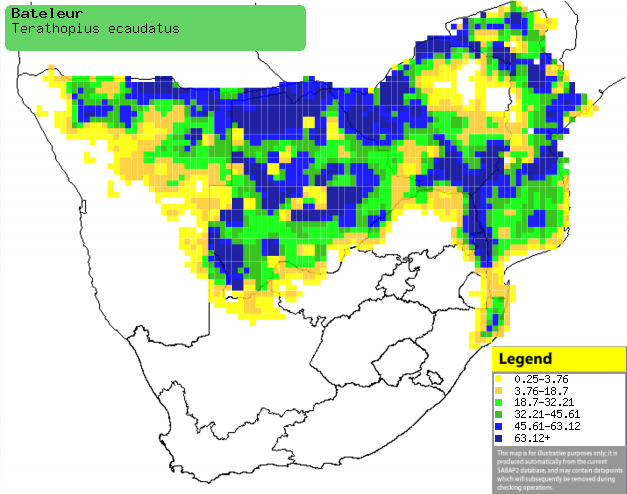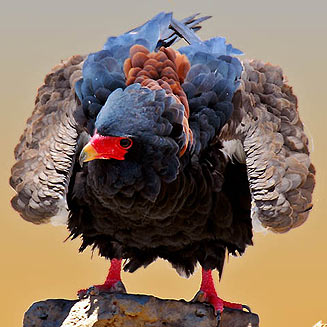|
Terathopius ecaudatus (Bateleur)
Berghaan [Afrikaans]; Ingqanga [Xhosa]; iNgqungqulu [Zulu];
Sipupa [Kwangali]; Chapungu [Shona]; Ingculungculu [Swazi]; Ximongwe
[Tsonga]; Ntsu, Pętlękę [Tswana]; bateleur, goochelaar [Dutch];
Bateleur des savanes [French]; Gaukler [German]; Águia-bailarina
[Portuguese]
Life
> Eukaryotes >
Opisthokonta
> Metazoa (animals) >
Bilateria >
Deuterostomia > Chordata >
Craniata > Vertebrata (vertebrates) > Gnathostomata (jawed
vertebrates) > Teleostomi (teleost fish) > Osteichthyes (bony fish) > Class:
Sarcopterygii (lobe-finned
fish) > Stegocephalia (terrestrial
vertebrates) > Tetrapoda
(four-legged vertebrates) > Reptiliomorpha > Amniota >
Reptilia (reptiles) >
Romeriida > Diapsida > Archosauromorpha > Archosauria >
Dinosauria
(dinosaurs) > Saurischia > Theropoda (bipedal predatory dinosaurs) >
Coelurosauria > Maniraptora > Aves
(birds) > Order: Falconiformes
> Family: Accipitridae
Distribution and habitat
Occurs across sub-Saharan Africa, excluding the lowland
forest of West Africa and the DRC. In southern Africa, it is locally
common in Mozambique, Zimbabwe, Botswana and northern and eastern Namibia and South Africa. It generally prefers savanna and woodland
habitats, such as arid Acacia savanna and miombo (Brachystegia)
woodland
and Mopane (Colosphermum mopane) woodland, especially with long grass. It
may also move into drainage-line woodland in semi-desert shrubland.
|
 |
|
Distribution of Bateleur in southern Africa,
based on statistical smoothing of the records from first SA Bird Atlas
Project (©
Animal Demography unit, University of
Cape Town; smoothing by Birgit Erni and Francesca Little). Colours range
from dark blue (most common) through to yellow (least common).
See here for the latest distribution
from the SABAP2. |
Predators and parasites
Nestlings are eaten by
Bubo
lacteus (Verreaux's eagle-owl).
Movements and migrations
Adults are largely sedentary, however juveniles
disperse from their parents territories once they become independent, sometimes travelling great
distances in search a territory. Juveniles
may also aggregate in their hundreds at certain sites in southern
Africa, suggesting that they may make large-scale movements.
Food
It is mainly a scavenger, although about a third of its
time is spent hunting, feeding on a variety of animals. It usually hunts
aerially, sometimes flying to veld fires, as it feeds
on animals killed by the heat or fleeing from it. It sometimes flies along roads in search
of roadkills to feed on. The following food items have been recorded
in its diet, either scavenged or hunted:
- Vertebrates
- mammals
- birds
- reptiles
- fish (caught when water is shallow)
- frogs
- Insects
Breeding
- Monogamous, territorial solitary nester, performing spectacular aerial
courtship displays in which the male repeatedly dives at and chases the
female, who often rolls to present her talons. These acrobatic flights give
the bird its name: "bateleur" is the French word for tight-rope walker.
- The nest is built mainly by the female in roughly six weeks, consisting
of a thin stick platform about 45-100 cm wide and 25-100 cm deep, with a cup
set into it, which is lined with green leaves. It is typically placed in the fork of a
large leafy tree, especially Knob thorn (Acacia nigrescens), Sycomore
fig (Ficus sycomorus) and Jackal-berry (Diospyros mespiliformisi).
It may rarely take over the nest of a
Wahlberg's eagle, instead of building it's own.
 |
 |
| Bateleur performing a display, the
purpose of which is not yet known.
[photo
Callie de Wet ©] |
- Egg-laying season is year-round, peaking from January-April.
- It lays a single egg, which is incubated by both sexes for roughly 55
days.
- Both sexes feed and brood the chick, taking turns to care for their
young in the early nestling period. Later, they only visit the nest to give
their young food; the chick takes its first flight at about 95-125 days old,
becoming fully independent about four months later.
Threats
Not globally threatened, but Vulnerable in South
Africa and Namibia, as its population in these countries is decreasing and it's range is
contracting. It is now restricted to protected areas, as it often falls victim
to persecution as well as dying from poisoned bait put out for jackals.
References
-
Hockey PAR, Dean WRJ and Ryan PG 2005. Roberts
- Birds of southern Africa, VIIth ed. The Trustees of the John Voelcker
Bird Book Fund, Cape Town.
|
